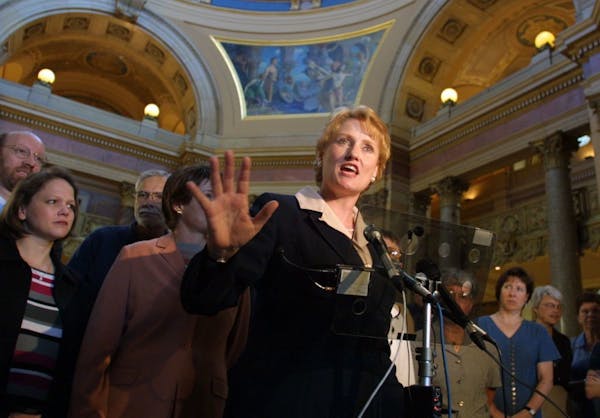Why do some major Twin Cities highways not connect directly?
Listen and subscribe to our podcast: Via Apple Podcasts | Spotify | Stitcher
Drivers on northbound Interstate 35W can easily access eastbound I-94 in downtown Minneapolis by taking a short ramp connecting the two major freeways.
For motorists on southbound I-35W who want to make the same movement, it's a case of you can't get there from here.
With no direct connection, drivers on southbound I-35W must exit at Washington Avenue, then snake their way through the confusing Seven Corners intersection in the Cedar Riverside neighborhood and follow Cedar Avenue several blocks to a partly obscured ramp leading to eastbound I-94.
When Ryan Sheahan moved to the Twin Cities 20 years ago, he said "it floored me that I could not get on [eastbound] 94 from [southbound]35W without going through a neighborhood. "It was like there is 94 and I'm still on 35."
Sheahan knows how to get around town now, but still wonders why some major metro highways do not have full interchanges? He asked Curious Minnesota, the Star Tribune's community reporting project fueled by reader's questions.
Transportation planners have to weigh costs and benefits for drivers when designing interchanges. They also have to determine if there is enough room for vehicles to safely enter and exit a freeway. In the case of adding a ramp from southbound I-35W to eastbound I-94 both were in short supply.
Because much of the Twin Cities highway system was designed in the 1960s and built in the 1970s after the downtowns and nearby neighborhoods were firmly established, adding that movement would have been very expensive, said Tom Fisher, a professor and director of the Minnesota Design Center at the University of Minnesota.
Roads back then "were designed to get people in and out of downtown as fast as possible," he said.
Jim Rosenow, a MnDOT engineer, added that in the 1960s, the interstate highway system was designed to move traffic from city to city and state to state, so the connection would not have been that important using those guidelines.
To add the missing connection, MnDOT would have had to build a flyover bridge, which would add even more complexity to the area that already resembles a spaghetti junction, with Hwy. 55 and ramps on I-94 at 6th and 7th streets also flowing into the area, Rosenow said.
A second option would have required acquiring a lot of land, which was not feasible since some of the land needed was owned by a railroad company. The Federal Highway Administration has no power to take land owned by the railroad, Fisher said.
Politics may have also played a role in the missing I-35W to I-94 link, said John Hourdos, director of the U's Traffic Observatory. A bypass route in the vicinity of Broadway Avenue connecting I-94 and I-35W was once considered, but that proposal ran into opposition, he said.
"A lot of times for political reasons traffic is forced to use regular roads so the local business don't get a hit," Hourdos said. "Today these reasons sound silly, but back then the concern was valid and opposition to freeways was strong especially for this reason."
Some of the same reasons explain why drivers in downtown St. Paul are forced to use city streets to get from eastbound I-94 to southbound I-35E and northbound I-35E to westbound I-94. A preliminary engineering document for the Capitol area showed a connecting roadway passing near the St. Paul Cathedral that would have provided for the missing interchanges. But somehow the connections were dropped, Rosenow said.
These interchanges were planned 60 years ago and "the difficulties they faced back then are like the ones we face now," Rosenow said. "You are not wanting to spend more money or displace more businesses than you need to."
Cost and space issues are likely behind the reason MnDOT didn't put in a connection from northbound Hwy. 100 to westbound I-94/694 in Brooklyn Center. With I-94, I-694 and Hwy. 252 merging nearby, there isn't a lot of traffic that would need it, so "this is one place to save some space [and money] and require those drivers to use surface roads to make the connection," said Raphael Stern, assistant professor of Civil, Environmental, and Geo- Engineering at the University of Minnesota.
Drivers there are directed onto Humboldt Avenue, then west on Freeway Boulevard to Shingle Creek Parkway where there is a ramp to westbound 94/694. Interchanges with missing connections are not unique to the Twin Cities. It's common across the country, particularly in major cities where space is limited, Stern said.
Sheahan, who moved to Minnesota from Illinois, said MnDOT could post better signage to help motorists forced to take a circuitous route find their way.
"Maybe it's easier now with maps on your phone," he said. "But I feel like they kind of don't want you to know where you are going."
---
If you'd like to submit a Curious Minnesota question, fill out the form below:
Read more Curious Minnesota stories:
Why do wild turkeys seem to thrive in the Twin Cities?
After Lake Calhoun, what about other place names with racist roots? What's the story behind three curiously named south metro roads?
Why is Minnesota the last state with 3.2 beer? Why is Minnesota more liberal than its neighboring states?
When you flush a toilet in the Twin Cities, where does everything go?
Was Minnesota home to nuclear missiles during the Cold War?


